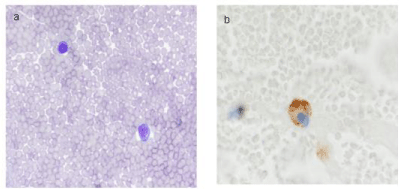
Case Report
Austin J Clin Case Rep. 2016; 3(4): 1098.
Extramedullary Pulmonary Hematopoiesis Presenting as Spontaneous Hemothorax in a Patient with Myelodysplastic Syndrome
Chaudhary R¹*, Singhal AL² and Sachdeva A²
¹Department of Internal Medicine, James J Peters VA Medical Center, USA
²Department of Pulmonary and Critical Care, University of Maryland Medical Center, USA
*Corresponding author: Radhika Chaudhary, Department of Internal Medicine, James J Peters VA Medical Center, USA
Received: June 29, 2016; Accepted: September 06, 2016; Published: September 10, 2016
Abstract
Extramedullary Hematopoiesis (EMH) is rare entity, associated with myeloproliferative disorders, myelodysplastic syndromes, hemolytic anemia, and storage disorders like Gauchers disease; though cases of EMH have been reported in absence of these conditions. Most common sites of EMH are the reticuloendothelial system. Uncommonly, EMH may affect the lungs and pleura and act as a marker of recurrence of underlying disease. We present a case of probable EMH presenting as spontaneous hemothorax that was secondary to the recurrence of underlying myelodysplastic syndrome.
Keywords: Extramedullary Hematopoiesis; Extramedullary bone marrow formation; Ectopic bone marrow; Myelodysplastic syndrome; Hemothorax; Pulmonary Hematopoiesis
Case Presentation
A 66-years-old gentleman with history of Myelodysplastic syndrome presented with new onset shortness of breath and bilateral lower extremity swelling. On evaluation he was found to have left side pleural effusion. Despite optimal medical management patient continued to have persistent symptomatic effusion, as such a diagnostic and therapeutic thoracentesis was performed. Two liters bloody fluid was removed after correction of coagulopathy. A few hours post-thoracentesis, patient’s respiratory status worsened and he required intubation and mechanical ventilation. The pleural fluid analysis revealed erythroblasts and megakaryocytes suggestive of extramedullary hematopoiesis (Figure 1). A CT scan of the chest revealed bilateral lung opacities suggestive of acute lung injury or bronchopneumonia. During this hospitalization, patient required one additional thoracentesis for symptom relief and the findings were similar to previous drainage. Given patient’s severe thrombocytopenia and preferred treatment choices, no additional diagnostic tests were performed to confirm the diagnosis of EMH [1,2]. He underwent chemotherapy, however given his poor response the patient and family decided to pursue hospice care and he passed away.

Figure 1: a) Pleural fluid cytology (Quick Diff Stain). b) Von Willibrand factor
Staining of Megakaryocyte.
Discussion
Extramedullary hematopoiesis is an uncommon disease entity which is characterized by ectopic nest of hematopoietic stem cells [3]. Most common site of EMH is the liver, spleen and reticuloendothelial system. Presentation ranges from abdominal pain, hepatosplenomegaly, portal hypertension, intra abdominal bleeding from spontaneous ruptures [4] or from injury. Lungs and pleura may also be involved. Pleuro-pulmonary involvement may lead to pleural effusion or thickening, pulmonary nodules or masses. The most common presenting complaint in pleuro-pulmonary involvement dyspnea though orthopnea, edema, weight gain, fatigue, fever etcmay also be the reason for presentation [5,6].
Various theories have been proposed to explain the pathophysiology of extrapulmonary hematopoiesis-asplenia (congenital or acquired) [5], compensation of dysplastic marrow [5], myelostimulatory theory [7,8]. Rare reports of EMH in absence of underlying myeloproliferative disorders suggest an underlying localized inflammatory state as the cause of EMH [2].
The diagnosis can be suspected in a setting of myeloproliferative disorder but can be confirmed only by tissue diagnosis. Presence of trilineage cells (erythriod, megakaryocytic, and myelocytic) confirm the diagnosis. In this patient the finding of erythroblast in pleural fluid in the setting of underlying myelodysplastic syndrome is suggestive of the diagnosis. Ali el al. [9] have reported the use of sulfur colloid scan alone in establishing the diagnosis of EMH.
Conclusion
Pulmonary extramedullary hematopoiesis is rare but should be considered as a differential diagnosis in patients with myeloproliferative disorders or MDS, presenting with pulmonary symptoms. In our patient it marked the recurrence of his myelodysplastic syndrome. Optimizing the treatment of underlying condition is the only effective treatment available as of now. Tissue diagnosis with demonstration the trilianeage cells of bone marrow stays the gold standard in establishing the diagnosis.
References
- Bowling MR, Cauthen CG, Perry CD, Patel NP, Bergman S, Link KM, et al. Pulmonary Extramedullary Hematopoiesis. J Thorac Imaging. 2008; 23: 138-141.
- Hosseinzadeh M, Omidifar N, Kumar PV, Rasekhi. Pulmonary extramedullary hematopoiesis in a patient with chronic asthma resembling lung cancer: a case report. Case Rep Med. 2012; 2012: 231787.
- Crum AV, Morris H, Hogan RN, Mancini R. Extramedullary hematopoietic lesion of the orbit presenting as a ring enhancing lesion. Opthal Plast Recon str Surg. 2013; 29: e8-e10.
- Eapen SS, Narayan R, Khan A. A case of unusual extramedullary hematopoiesis. Journal of clinical oncology. 2004; 22: 6698.
- Koch CA, Li CY, Mesa RA, Tefferi A. Non hepatosplenic extramedullary hematopoiesis: associated diseases, pathology, clinical course and treatment. Mayo Clinic proc. 2003; 78: 1223-1233.
- Asakura S, Colby TV. Agnogenic myeloid metaplasia with extramedullary hematopoiesis and fibrosis in the lung. Chest. 1994; 105: 1866-1868.
- Laszlo J. Myeloproliferative disorders (MPD): myelofibrosis, myelosclerosis, extramedullary hematopoiesis, undifferentiated MPD, and hemorrhagic thrombocythemia. Semin Hematolo. 1975; 12: 409-432.
- Ward H, Block MH. The natural history of agnogenic myeloid metaplasia and critical evaluation of its relationship with the myeloproliferative syndrome. 1971; 50: 357-420.
- Ali SZ, Clarke MJ, Kannivelu A, Chinchure D, Srinivisan S. Extramedullary pulmonary hematopoiesis causing pulmonary hypertension and severe tricuspid regurgitation detected by technetium -99m sulfur colloid bone marrow scan and single photon emission computed tomography/CT. Korean J Radiology. 2014; 15: 376-380.